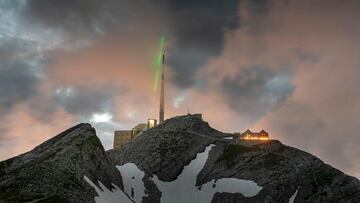Scientists use laser technology to change the direction of lightning strikes
After setting up a massive laser atop a Swiss mountain, researchers were able to influence the path of lightning bolts in real time.


Researchers in Switzerland have managed to change the course of a bolt of lightning using lasers, demonstrating the technique in a real-world environment for the very first time.
Aurélien Houard, a physicist at Institut Polytechnique de Paris in Palaiseau, and a team of colleagues set up a powerful laser on top of the Santis Mountain in northern Switzerland and bent lightning towards the structure.
Their findings were published in the latest edition of Nature Photonics, released 16 January. This method has been performed in laboratories before, but this marks the first time that scientists have changed the direction of lightning in real storms.
“Metal rods are used almost everywhere to protect from lightning, but the area they can protect is limited to a few metres or tens of metres,” Houard explained.
“The hope is to extend that protection to a few hundred metres if we have enough energy in the laser.”
A paper in @NaturePhotonics demonstrates a powerful laser aimed at the sky that can create a virtual lightning rod and divert the path of lightning strikes. The findings may pave the way for better lightning protection methods for critical infrastructure. https://t.co/UPmx3Nsd4s pic.twitter.com/4pAGVfHgrK
— Nature Portfolio (@NaturePortfolio) January 17, 2023
How did scientists bend lightning?
To understand how they achieved this remarkable feat, it is first important to understand what lightning is. Lightning bolts are essentially huge electrical discharges that result from static electricity in the atmosphere.
A single bolt can span up to three miles and the electrical charge it carries is so powerful that it can reach temperatures of more than 50,000°F.
Houard’s team set up a powerful laser next to a 400ft telecommunications tower that is hit by lightning approximately 100 times a year. They hoped to show that the presence of the laser, and the huge electrical charge it creates, would form an electrical path through the sky and draw the lightning bolt in that direction.
When storm clouds gathered around the site last summer, researchers fired rapid laser pulses in a bid to divert the course of any lightning bolts that should emerge. Recording equipment suggested that four discharges were taken off course by their efforts.
Laser-guided lightning! New #openaccess article.
— Nature Photonics (@NaturePhotonics) January 16, 2023
Experiment on the Säntis mountain in Switzerland with a terawatt laser confirmed laser-induced filaments successfully guided 4 out of 4 lightning strikes while the system was active.https://t.co/8j6x6hCJnY#laser #lightning pic.twitter.com/Qq84xnXPO7
On one occasion the storm took place at a time when conditions were sufficiently clear for the phenomenon to be recorded on high-speed cameras. The footage they captured shows that, for around 160ft, the lightning bolt deviated from its course to follow the path of the laser. From this, they deduced that it was the presence of the lasers that changed the direction of the lightning.
Related stories
For now there is little chance of wide-scale usage of this type of technology. Not only is it incredibly expensive, far more costly the lightning rods typically used today, but it is not safe to use in many situations. The powerful laser would be a risk to air traffic and could seriously damage pilots’ eye.
But Professor Manu Haddad, director of Cardiff University’s Morgan-Botti Lightning Laboratory, remains optimistic about possible future applications. He said: “Lasers could be a more reliable way to direct the lightning discharge, and this may be important for the lightning protection of critical ground installations and equipment.”
